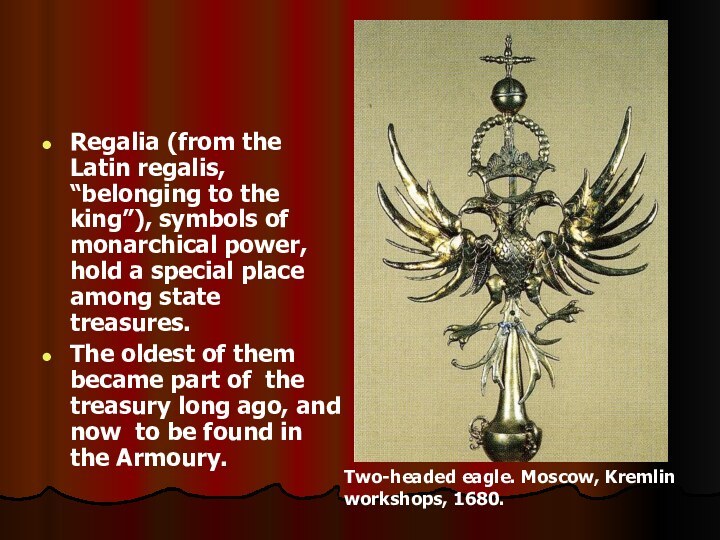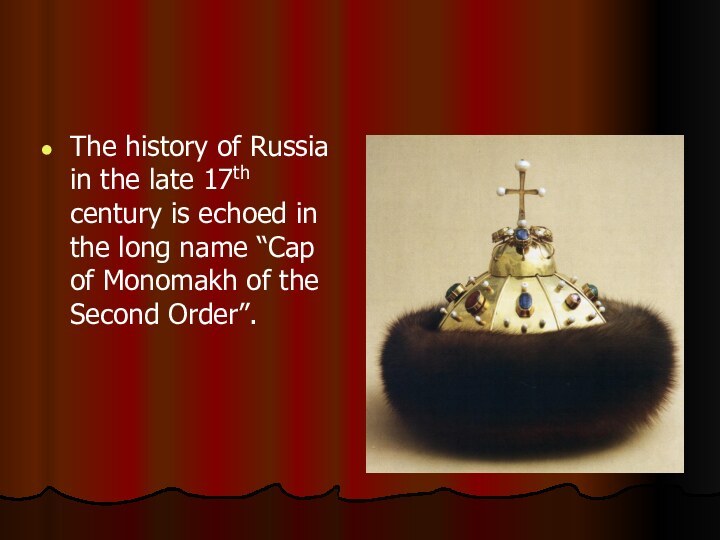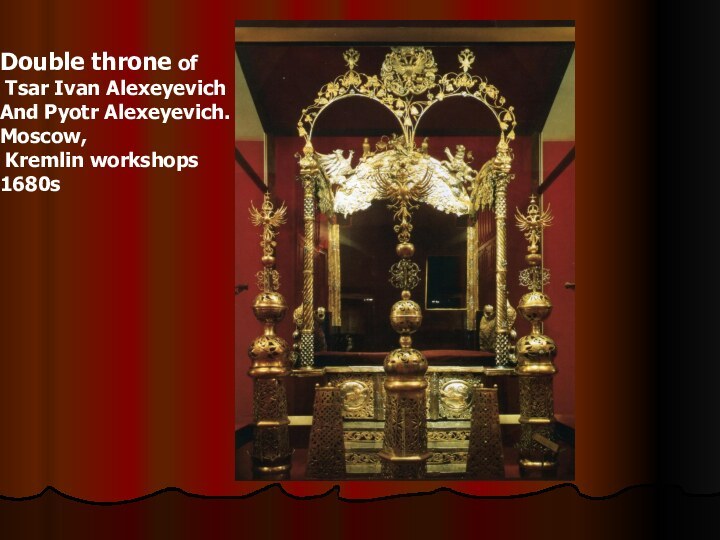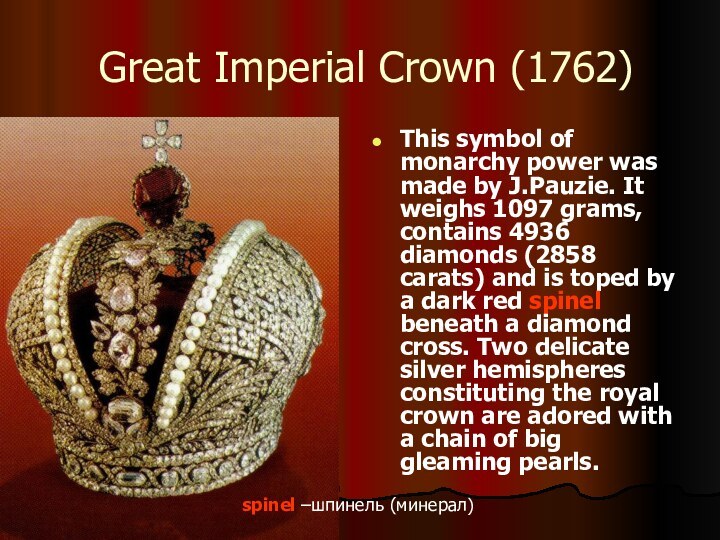Слайд 2
Regalia (from the Latin regalis, “belonging to the
king”), symbols of monarchical power, hold a special place
among state treasures.
The oldest of them became part of the treasury long ago, and now to be found in the Armoury.
Two-headed eagle. Moscow, Kremlin workshops, 1680.
Слайд 3
The first ceremonial consecration of a grand prince
in the history of Russia took place five hundred
years ago, at the end of 15th century, during the reign of
Ivan III, when the unification of Russian lands under the rule of Moscow was largely completed.
Consecration-посвящение
Слайд 4
The consecration of Dmitry, proclaimed heir to Ivan
III, took place on 4 February, 1498, in the
Dormition Cathedral in the Moscow Kremlin.
The culmination of this ceremony came when Dmitry was attired in barma and crown- the famous Cap of Monomakh- the very first attributes of supreme power in the state of Moscow.
Слайд 5
Barmas of Tsar Alexey Mikhailovich. Istambul, 1662
Cap of
Monomakh. The Orient, larte 13th –early 14th century.
Слайд 6
From 1547- the year of the consecration of
the first Russian Tsar, Ivan Vasilyevtich ( the Terrible)-
up to the end of the 17th century, the Cap of Monomakh was used at the consecration of every Russian sovereign. It became the most honored attribute of royal power, symbolizing the responsibility of the tsar to his subjects.
Слайд 7
Remember the words by Pushkin: ”Oh, how heavy
you are, Cap of Monomakh”.
Portrait of Tsar
Mikhail
Fyodorovich.
Crown, sceptre and orb of tsar
Mikhail Fyodorovich
Слайд 8
Kazan Cap of Tsar
Ivan the Terrible
Слайд 9
Portrait of Tsar Ivan the Terrible
H. Vaigel.
Nuremberg, Second
half of the 16th century.
Слайд 10
Diamond Cap of Tsar Ivan Alexeyevich. Moscow,
Kremlin
workshops. 1680s
Слайд 11
Diamond Cap of Tsar Peter the Great.
Moscow, Kremlin
workshops, 1680s.
Слайд 12
“Platno” (state robe)
of Tsar Peter the Great.
Moscow,
Kremlin workshops,
17th century
Cross of Tsar Peter
the
Great
Слайд 13
Portrait of Tsar Peter the Great.
Netherlands 1698
P.Van Gunst
Слайд 14
The history of Russia in the late 17th
century is echoed in the long name “Cap of
Monomakh of the Second Order”.
Слайд 15
Following the death of the childless Tsar Fyodor
Alexeyevich in April, 1682, the throne was to pass
to his brother, the fifteen-year old Ivan Alexeyevich.
The Boyar Duma (concil) proclaimed the younger brother of Fyodor and Ivan, the ten-year old Tsarevich Pyotr, tsar.
Later both brothers were proclaimed tsars.
During the consecration of them, the ancient Cap pf Monomakh was placed on the head of Ivan and the Cap of Monomakh of the Second Order, specially made on that occasion , was placed on the head of Peter.
Слайд 16
Double throne of
Tsar Ivan Alexeyevich
And Pyotr Alexeyevich.
Moscow,
Kremlin workshops
1680s
Слайд 17
The state sword 17th century.
In 1742, during
the coronation of
Empress Elizabeth, the state sword
made
its first appearance.
It served to remind the monarch
of the royal duty
to defend good and punish evil.
The Russian state sword was
made over a period of time.
Its blade dates back to the
17th century while the handle
and the sheath date to the
18th century. The design of the
handle is heavily ornamental,
consisting of eagle heads
and crown cast in silver.
Слайд 19
It is difficult to say precisely when the
state shield was first used in a coronation ceremony,
but it is possible that this also dates back to the 18th century.
The shield has traditional circular shape, and it is covered with red and velvet decorated with agraffes made of jade, rock crystal and colored stones, mainly 17th century Turkish work.
Jade-жадеит
Слайд 20
At the coronation ceremony held at Uspensky (Assumption)
Cathedral Catherine the Great appeared a true empress. She
was wearing a crown and was carrying a sceptre in her right hand and orb in her left one.
Слайд 21
Imperial Sceptre
Imperial Sceptre
( a small mace symbolizing
the Absolute power) carried at the coronation ceremony by
Catherine the Great did not live to our times. The one made at the beginning of 1770s is exhibited at the Diamond Fund.
Mace-жезл
Слайд 22
Imperial Orb
This orb was made in 1762 for
Catherine the Great.
The Indian diamond of the first water
weighing approximately 50 carats was mounted at the cross of ribbons, and a huge Ceylon sapphire of 200 carats crowned the orb.
Слайд 23
Great Imperial Crown (1762)
This symbol of monarchy power
was made by J.Pauzie. It weighs 1097 grams, contains
4936 diamonds (2858 carats) and is toped by a dark red spinel beneath a diamond cross. Two delicate silver hemispheres constituting the royal crown are adored with a chain of big gleaming pearls.
spinel –шпинель (минерал)
Слайд 24
Small Imperial Crown.
It weighs 378 grams :
there
are 48 big (from 2 to 9 carats)
and
20 small diamonds in it.
Crown Of Empress Anna Ioannovna.
St Peterburg, 1730
























